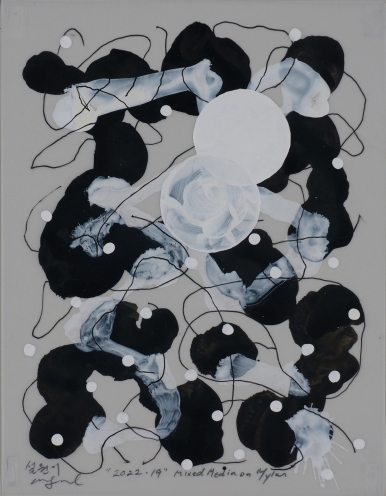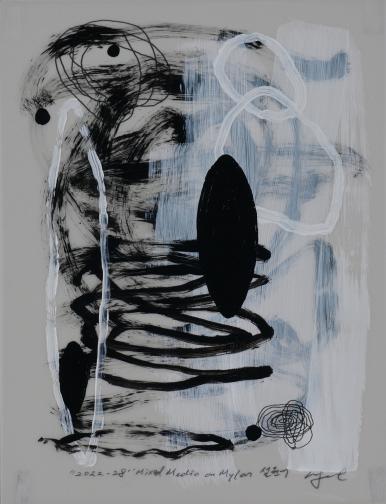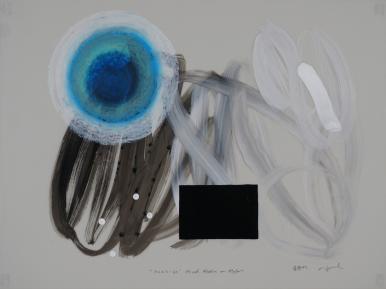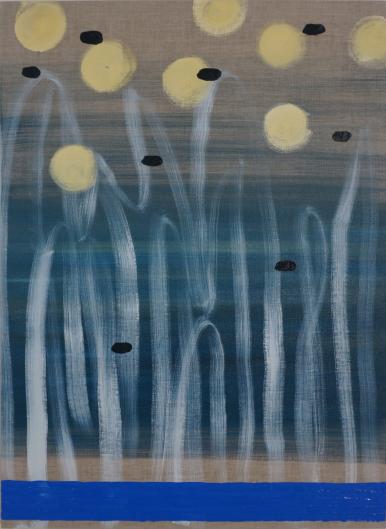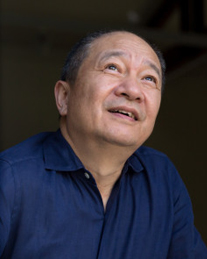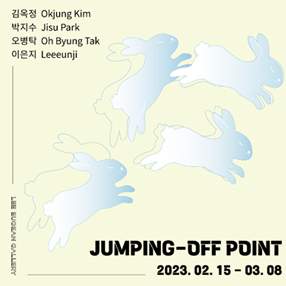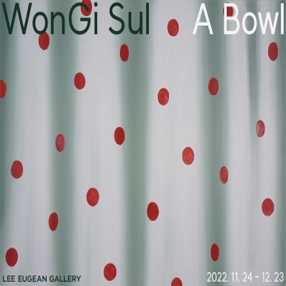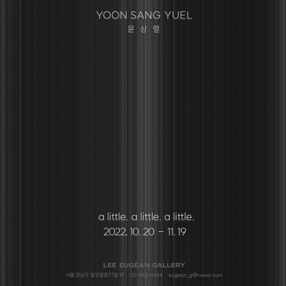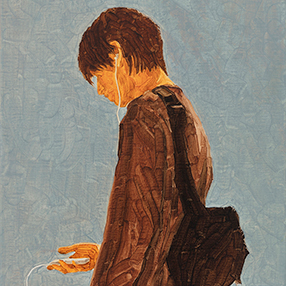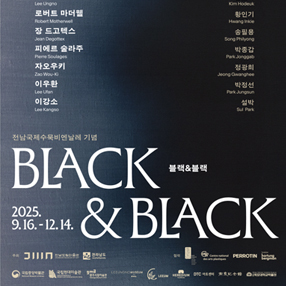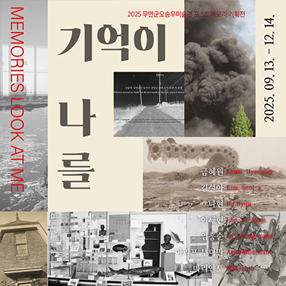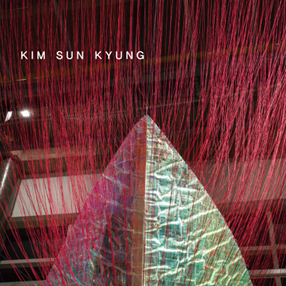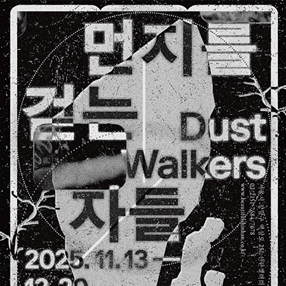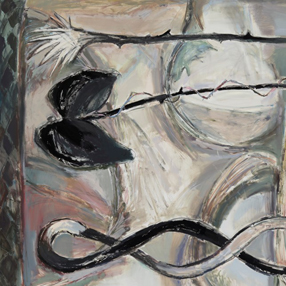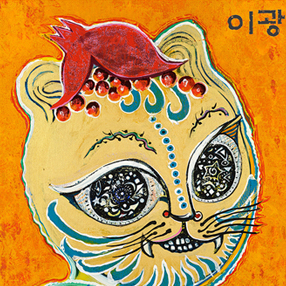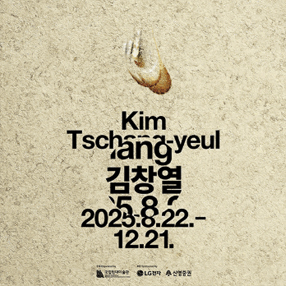본문
-
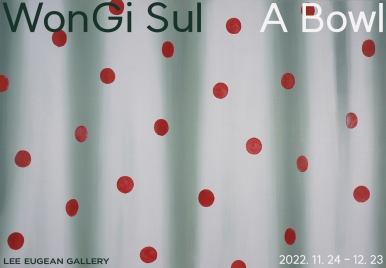
전시 포스터
-
설원기
2022-19, mixed media on mylar, 28x21.5cm, 2022
-
설원기
2022-28, mixed media on mylar, 28x21.5cm, 2022
-
설원기
2022-60, mixed media on mylar, 46x61cm, 2022
-
설원기
2022-88, oil on linen, 100x73cm, 2022
-
Press Release
설원기의 작품론-시론
- 양정무, 미술사학자
바우하우스에 칸딘스키가 있었다면, 미술원에는 설원기가 있었다. 칸딘스키가 1922년 바우하우스에 교수로 초대되어 1933년까지 11년간 재직하며 혁신적 교육을 이끌었다면, 설원기는 한국예술종합학교 미술원 설립 직후인 1998년부터 미술원에 부임하면서2017년까지 19년간 파운데이션에서 스튜디오로 이어지는 미술원 교육의 핵심과정을 설계하고 안착시켰다.
미술사적으로 칸딘스키의 작품세계는 교육자로서의 그의 정체성과 병렬적으로 비교한다. 마찬가지로 나는 설원기의 작가적 태도도 그의 교육자적 철학과 등가적으로 바라봐야 한다고 생각한다.
칸딘스키는 바우하우스의 벽화담당 공방 교수로 시작하여 점차 형태교육을 책임지게 되며 무엇보다도, 예비과정에 있어서 이론수업을 주도하였다. 이론교육에 있어서 칸딘스키는 예술에서 이론보다 실제가 우선된다고 강조하였지만, 조형의 원리를 불변하는 법칙으로 엄격하게 제시한 것으로 알려져 있다. 결과적으로 칸딘스키의 수업은 “학생들의 자유로운 상상력과 표현을 구속함으로써 원칙이 수단에서 벗어나 목적이 되는 모순을 보여준다”는 평가를 받고 있다.¹
설원기는 미술원 부임 이듬해인 1999년 파운데이션 교육을 동료 교수인 윤동구와 함께 주도하였다. 바우하우스의 형태교육과 이론교육에 비견될 수 있는 미술원의 파운데이션은 기본적으로 미국 대학미술 교육의 연장선에 있다. 매우 강도 높은 기초조형 교육으로 알려져 있으나 그것의 적용에 있어 매우 유연한 사고를 요구했다. 그는 파운데이션 교육과정을 엮은 자신의 저서에서 강의 내용과 창작 기법이 교수 성향에 따라 한정 짓는 교육에 명확히 반대하고 있다. 여기서 그는 “학생 개인이 자신에게 맞는 어떤 기법을 스스로 찾아낼 수 있는 능력을 지향한다”고 주장하였다.²
이러한 교수 중심의 교육에서 학생 중심의 교육으로 교육 주체의 변화는 다분히 포스트모던 미술교육의 전환과 맞닿아 있지만 크게 보면 그의 작품세계와 정확히 연계된다는 점에서 그 시사점이 더 크다고 할 수 있다.
사실 칸딘스키와 설원기는 미술교육자로의 역할 뿐만 아니라 회화적으로도 흥미롭게 대구를 이룬다. 칸딘스키는 그림을 감정에 대한 사실적 이미지로 봤는데, 설원기도 이와 동일한 태도를 보여준다. 예를 들어 다음 두 작품은 칸딘스키와 설원기의 회화적 세계에 있어 공통점과 차이점을 명시적으로 보여준다.
칸딘스키에 있어서 기초적 조형언어는 그의 저서 『점, 선, 면』(1926)에서 언명한 것처럼 명확하고 논리적인 이성적 세계이다. 칸딘스키의 화면에서 보이는 동심원과 사각형, 직선의 그물망은 설원기의 작품에서도 확인되나 그 형태는 모호하다. 칸딘스키의 조형원리가 확신에 기초한다면, 설원기의 조형원리는 유연함에 기초한다. 마치 칸딘스키가 이성과 논리에 기초한 불변의 법칙을 이론적으로 강조하면서 ‘발화자로서의 작가’에 확신했다면, 설원기는 자율에 기초한 수평적 시각모델을 교육뿐만 아니라 창작에서도 강조하면서 ‘토론자로서의 작가’를 모색했다고 할 수 있다.
칸딘스키는 자신의 회화를 음악으로 설명했는데, 그의 해석에 따르면 그의 회화는 고전주의적, 낭만주의적 음악의 현현이다. 실제로 그는 자신의 조형원리를 베토벤의 교향곡에 비유해 소개하였다. 이 관점에서 보면 그의 「컴포지션 VIII」의 동심원은 강한 타격에 의한 거대한 파동이며 나머지는 그것에 의한 다채로운 변주로 다가온다.
설원기의 「2022-60」도 음악적이지만 모호한 경계와 비선형적 움직임으로 비결정적이다. 칸딘스키가 음악의 고전적 어법을 현대 미술에서 추상으로 구현했다면, 설원기의 태도는 이와 명확히 구분되는 비고전, 탈고전적 음악이다. 사실 나에게 그의 추상적 화면은 물리학, 특히 유체역학(fluid mechanics)의 세계처럼 신비롭게 다가온다. 회오리바람이나 역류하는 물길처럼 불규칙적이며 측정 불가능한 세계에 대한 유려한 회화적 응답이다.
설원기는 막스 베크만(Max Beckmann)의 말 “미술 그 자체는 가르칠 수 없다. 그러나 미술의 길을 가르칠 수는 있다(You cannot teach art, but you can teach the way of art)”는 주장을 언급하곤 했다. 베크만처럼 설원기 자신은 미술과 대화하는 보다 유연하고 가변적인 새로운 조형언어를 모색하려 했고 그것을 창작과 교육, 두 영역 모두에서 구현하려 했다. 따라서 설원기의 작품세계에 대한 어떠한 분석도 그가 새로운 조형모델을 창작과 교육의 영역에서 도달하려 했다는 점을 빼놓고 이루어질 수 없을 것이다. 아쉽게도 이 지점이 그간 설원기의 작가론에서 결여되어 있기에 그의 작품에 대한 논의는 이제부터 시작이라고 할 수 있다.³
¹ 송혜영, 바우하우스의 교육과정 -바실리 칸딘스키의 통합교육을 중심으로-, 기초조형학연구, 제18권 제2호, 2017, p.295-308.
² 설원기, 『더 파운데이션 워크북 The Foundation Workbook』, 한국예술종합학교, 2002, p.17.
³ 칸딘스키의 경우 두 권의 책. 『예술에서의 정신적인 것에 관하여』, 『점, 선, 면』을 통하여 자신의 작품 세계에 대한 이론서를 남겼다면, 설원기의 『더 파운데이션 워크북』은 그의 작품세계에 관한 이해의 출발선이 될 것이다. 미술원 파운데이션에 대한 종합적 연구가 현재 미술이론과 김태희 학생의 전문사 학위 논문으로 진행 중에 있다.
Discourse on WonGi Sul’s Art: Seminal Research
- Jeongmu Yang, Art Historian
If there was Wassily Kandinsky at the German arts school Bauhaus, there is WonGi Sul at the School of Fine Arts of Korea National University of Arts (KNUA). Kandinsky led a program of innovative education after being invited to teach at the Bauhaus as a professor in 1922 and working there through 1933. WonGi Sul, however, became a professor at the School of Fine Arts in 1998 immediately after its inception at KNUA. Through 2017, he designed and set core courses of art education for 19 years starting with those on art foundation and later setting up others on studio.
In art history, the world of Kandinsky’s works is juxtaposed with his identity as an educator. Likewise, Sul’s attitude as an artist should also be seen through the same perspective on his philosophy as an educator.
Kandinsky started his professorship by conducting the Wall Painting Workshop at the Bauhaus and gradually took on the responsibility of shaping education on form. Above all, he supervised the preliminary course on theory and in teaching the subject, he emphasized that practice precedes theory in art yet was known for presenting the formative principles as immutable laws in a strict fashion. As a result, Kandinsky’s lecture is evaluated as “displaying the contradiction of principle moving beyond the position of a means and turning into an end by constraining the students’ uninhibited imagination and expression.”¹
A year after assuming his post at KNUA, Sul in 1999 led education on art foundation with fellow professor Yoon Dong-gu. The education offered at the School of Fine Arts, comparable to that on form and theory at the Bauhaus, is basically an extension of education offered at American art schools. While considered an intensive course on basic form, the KNUA's curriculum also required flexible thinking in its application. In his book, The Foundation Workshop, in which Sul compiled the curriculum for foundation education, he demonstrates clear opposition to the kind of education in which course content and creative techniques are limited by a professor’s preference. Here, he said “this education is geared toward developing each student’s ability to find a technique that is suitable for oneself.”² The change in the agency of education from a professor- to student-centric model is related to the transition of post-modern art education, but in a broader sense, the greater implication is its link to the world of Sul’s works.
Kandinsky and Sul form an interesting parallel not only through their roles as art educators but also their paintings. Kandinsky perceived paintings as realistic images reflecting human emotions, and Sul presented an identical attitude. For instance, the following two works explicitly manifest the similarities and differences in the paintings of both artists.
As described in Point and Line to Plane (1926), to Kandinsky, the basic formative language was a clear and logical world of reason. The concentric circles, squares, and web of straight lines in his painting are also identified in Sul’s work, but the forms in the latter painting are ambiguous. If Kandinsky’s formative principle is based on conviction, Sul's is based on flexibility. Kandinsky stressed an immutable law based on reason and logic in theory and strongly envisioned an “artist as a speaker,” whereas Sul underscored the horizontal visual model based on autonomy not only in education, but also in the creative process and championed the “artist as a debater.”
Kandinsky explained his paintings through music, which according to him were a manifestation of classical and Romantic music. He introduced his formative principles by making an analogy with Beethoven’s symphonies. From this point of view, the concentric circles in his Composition VIII represent huge waves caused by a strong blow and the rest as the resulting colorful variations.
Sul’s 2022-60 is just as musical but contains an aspect of indeterminacy caused by its blurred boundaries and non-linear movements. If Kandinsky embodied the classical grammar of music in contemporary art through abstraction, Sul assumes an attitude of non- and post-classical music clearly distinct from Kandinsky’s. Sul’s abstract picture seems as mysterious as the world of physics, especially fluid mechanics. This is a refined response through painting to an irregular and unmeasurable world like a whirlwind or a current that flows backward.
Sul often referred to the argument by Max Beckmann: “You cannot teach art, but you can teach the way of art.” Like Beckmann, Sul has sought a new formative language more flexible and variable to communicate with art and tried to embody it through both art creation and education. So analysis of his works is not possible if his efforts to arrive at a new formative model both in creating and teaching art are excluded. Unfortunately, this aspect has seen little exploration in the study of Sul as artist, which is to say that discussion on his art world has only just begun.³
¹ Song Hai Young, “Education Course of Bauhaus: focused on Wassily Kandinsky’s integrated education,” Journal of Basic Design and Art, Vol. 18, No. 2, 2017, 295–308.
² Sul WonGi, The Foundation Workbook, Korea National University of Arts, 2002, 17
³ While Kandinsky wrote two books on the theories behind his art world, Concerning the Spiritual in Art and Point and Line to Plane, The Foundation Workbook is the starting point in understanding Sul’s art world. A comprehensive study on the workbook at KNUA’s School of Fine Arts is ongoing as part of Kim Tae-hui’s master’s thesis from the Department of Art Theory.전시제목설원기: 그릇 A Bowl
전시기간2022.11.24(목) - 2022.12.23(금)
참여작가 설원기
관람시간11:00am - 06:00pm
휴관일매주 일요일 및 공휴일 휴관
장르회화
관람료무료
장소이유진갤러리 LEE EUGEAN GALLERY (서울 강남구 압구정로77길 17 (청담동) )
연락처02-542-4964
-
Artists in This Show
-
1951년 서울출생
-
이유진갤러리(LEE EUGEAN GALLERY) Shows on Mu:umView All
Current Shows
-
BLACK & BLACK
전남도립미술관
2025.09.16 ~ 2025.12.14
-
기억이 나를 본다
무안군오승우미술관
2025.09.13 ~ 2025.12.14
-
원문자: 사유공간 思惟空間
이천시립월전미술관
2025.10.16 ~ 2025.12.14
-
유리상자-아트스타Ⅲ 김선경 [無와 有의 경계에서]
봉산문화회관
2025.09.12 ~ 2025.12.14
-
먼지를 걷는 자들 Dust Walkers
신한갤러리
2025.11.13 ~ 2025.12.20
-
유리: 투명한 고리
갤러리 학고재
2025.11.19 ~ 2025.12.20
-
이광 개인전 《우주호랑이- 호랑이 여자로 산다는 것은》
갤러리 마리
2025.11.21 ~ 2025.12.20
-
김창열
국립현대미술관
2025.08.22 ~ 2025.12.21




